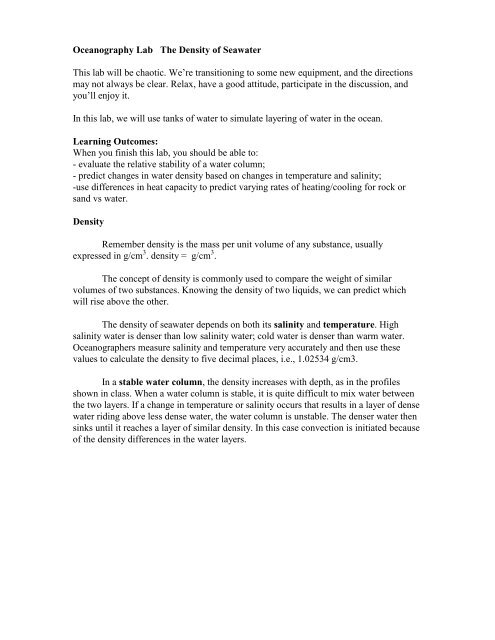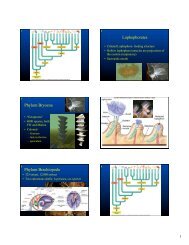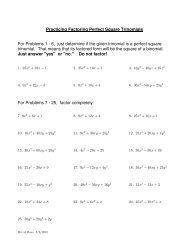Oceanography Lab The Density of Seawater - Faculty
Oceanography Lab The Density of Seawater - Faculty
Oceanography Lab The Density of Seawater - Faculty
You also want an ePaper? Increase the reach of your titles
YUMPU automatically turns print PDFs into web optimized ePapers that Google loves.
<strong>Oceanography</strong> <strong>Lab</strong> <strong>The</strong> <strong>Density</strong> <strong>of</strong> <strong>Seawater</strong><br />
This lab will be chaotic. We’re transitioning to some new equipment, and the directions<br />
may not always be clear. Relax, have a good attitude, participate in the discussion, and<br />
you’ll enjoy it.<br />
In this lab, we will use tanks <strong>of</strong> water to simulate layering <strong>of</strong> water in the ocean.<br />
Learning Outcomes:<br />
When you finish this lab, you should be able to:<br />
- evaluate the relative stability <strong>of</strong> a water column;<br />
- predict changes in water density based on changes in temperature and salinity;<br />
-use differences in heat capacity to predict varying rates <strong>of</strong> heating/cooling for rock or<br />
sand vs water.<br />
<strong>Density</strong><br />
Remember density is the mass per unit volume <strong>of</strong> any substance, usually<br />
expressed in g/cm 3 . density = g/cm 3 .<br />
<strong>The</strong> concept <strong>of</strong> density is commonly used to compare the weight <strong>of</strong> similar<br />
volumes <strong>of</strong> two substances. Knowing the density <strong>of</strong> two liquids, we can predict which<br />
will rise above the other.<br />
<strong>The</strong> density <strong>of</strong> seawater depends on both its salinity and temperature. High<br />
salinity water is denser than low salinity water; cold water is denser than warm water.<br />
Oceanographers measure salinity and temperature very accurately and then use these<br />
values to calculate the density to five decimal places, i.e., 1.02534 g/cm3.<br />
In a stable water column, the density increases with depth, as in the pr<strong>of</strong>iles<br />
shown in class. When a water column is stable, it is quite difficult to mix water between<br />
the two layers. If a change in temperature or salinity occurs that results in a layer <strong>of</strong> dense<br />
water riding above less dense water, the water column is unstable. <strong>The</strong> denser water then<br />
sinks until it reaches a layer <strong>of</strong> similar density. In this case convection is initiated because<br />
<strong>of</strong> the density differences in the water layers.
Experiment 1. <strong>The</strong> <strong>The</strong>rmocline<br />
In this experiment you will fill half the tank with<br />
hot water and the other half <strong>of</strong> the tank with cold<br />
water. <strong>The</strong>n you will remove the divider and<br />
observe what happens.<br />
1. Formulate a hypothesis.<br />
What will happen when the divider is removed<br />
hot water cold water<br />
and the hot water is allowed to interact with the cold water? Describe your hypothesis by<br />
coloring in the tank showing hot water in red and cold water in blue. Write a few<br />
explanatory sentences below the tank.<br />
tank<br />
2. Carry out your experiment.<br />
a. Put a divider in the center slot <strong>of</strong> the tank.<br />
b. Slide the thermometer apparatus onto the long, clear side <strong>of</strong> the tank. <strong>The</strong> battery is on<br />
the outside <strong>of</strong> the tank.<br />
c. Simultaneously fill one half <strong>of</strong> the tank with hot water from the water heater, and the<br />
other half <strong>of</strong> the tank with cold water from the ice water bath. No ice goes into the<br />
tank. Fill the tank to the zero line on the thermometer apparatus.<br />
d. Put a small amount <strong>of</strong> red dye into the hot water and a small amount <strong>of</strong> blue dye into<br />
the cold water—just enough to see different colors. <strong>The</strong> waters don’t need to be dark.<br />
e. Remove the divider from the center slot.<br />
f. What happened? Did your results match your hypothesis? Describe what happened<br />
using a drawing and a few sentences here:<br />
tank<br />
Did the results match<br />
your hypothesis? Why<br />
or why not?<br />
Which is more dense, warm water or cold water?<br />
Do not empty your tank. Please go on to Part 3 on the next page.<br />
What will happen when<br />
this divider is removed?
3. Measure the <strong>The</strong>rmocline<br />
a. Follow the instructions on how to use the thermometer apparatus.<br />
b. Be careful to not disrupt the layering in the water.<br />
c. When the water settles, read the temperature<br />
every centimeter.<br />
d. Record the temperatures on the table below.<br />
Temperature, C<br />
Depth, from surface, cm<br />
Depth, cm Temperature<br />
from apparatus<br />
1<br />
2<br />
3<br />
4<br />
5<br />
6<br />
7<br />
8<br />
9<br />
10<br />
4. Plot the temperature measurements on the graph above right.<br />
a. Note the range <strong>of</strong> your temperature measurements from lowest to highest values to<br />
determine the best scale to use on the graph. Each <strong>of</strong> the squares on the graph should<br />
represent an equal interval. You must decide what on the best interval to use.<br />
b. Write labels for the temperature scale in the space directly above the graph.<br />
c. Plot your values on the graph.<br />
5. Shade in the depth range that represents the thermocline on the graph.<br />
a. Remember the thermocline is a range <strong>of</strong> depth where the temperature changes quickly<br />
with respect to depth.<br />
b. Shade in this depth range on your graph and label it with the word “thermocline”.<br />
Do not empty your tank. Please go on to Part 6 on the next page.<br />
Depth, cm<br />
1<br />
2<br />
3<br />
4<br />
5<br />
6<br />
7<br />
8<br />
9<br />
10
6. Stability <strong>of</strong> a stratified water column<br />
a. Apply a gentle surface wind along the long dimension<br />
<strong>of</strong> the tank. Do this by either blowing on it or by<br />
using the bellows supplied to you.<br />
b. Remember this is only a very small tank. <strong>The</strong> ocean is<br />
proportionately much bigger.<br />
Does a gentle wind cause mixing between the layers in<br />
this tank experiment?<br />
Will a very strong wind cause mixing in the real ocean?<br />
In the ocean, wind drift currents are limited to the top 100 meters or so, which is<br />
generally above the pycnoclone.<br />
Experiment 2. the Halocline<br />
In this experiment you will fill half the tank with 100‰<br />
water and the other half <strong>of</strong> the tank with fresh water.<br />
<strong>The</strong>n you will remove the divider and observe what<br />
happens.<br />
What will happen when<br />
this divider is removed?<br />
1. Formulate a hypothesis.<br />
What will happen when the divider is removed<br />
and the 100‰ water is allowed to interact with<br />
100‰,water fresh water<br />
the fresh water? Describe your hypothesis by coloring in the tank showing 100‰ water in<br />
red and fresh water in blue. Write a few explanatory sentences below the tank.<br />
tank
2. Carry out your experiment.<br />
a. Put a divider in the center slot <strong>of</strong> the tank.<br />
b. Simultaneously fill one half <strong>of</strong> the tank with 100‰ water from the appropriate tank,<br />
and the other half <strong>of</strong> the tank with fresh tap water. Fill the tank to about 1 cm from the<br />
top. Use a ruler.<br />
c. Put a small amount <strong>of</strong> red dye into the 100‰ water and a small amount <strong>of</strong> blue dye<br />
into the fresh water—just enough to see different colors. <strong>The</strong> waters don’t need to be<br />
dark.<br />
d. Remove the divider from the center slot.<br />
e. What happened? Did your results match your hypothesis? Describe what happened<br />
using a drawing and a few sentences here:<br />
tank<br />
In what ways did your<br />
results match<br />
your hypothesis?<br />
Which is more dense,<br />
100‰ water or fresh water?<br />
3. Pumice in the tank.<br />
What happens when you drop a small piece <strong>of</strong> pumice into the tank?<br />
Why does this happen?
Experiment 3. Layering <strong>of</strong> Ocean Water Masses<br />
a. Put a divider in the center slot <strong>of</strong> the tank.<br />
b. Simultaneously fill one half <strong>of</strong> the tank with 15‰<br />
water from the appropriate tank, and the other half <strong>of</strong><br />
the tank with 50‰ water. Fill the tank to about 1 cm<br />
from the top. Use a ruler.<br />
c. Do not put any dyes into these waters.<br />
d. Meanwhile, put a few milliliters <strong>of</strong> 100‰, 35‰, and<br />
fresh water in separate, labeled beakers.<br />
e. Put a different dye in each beaker. Make these dark enough to really see. Later, after<br />
removing the center divider, we will put these dyed waters into the tank.<br />
Where do you expect the different salinity waters will end up?<br />
f. Remove the divider from the center slot.<br />
g. With eyedroppers, add a few eye-dropper-sized quantities <strong>of</strong> each <strong>of</strong> the dyed waters<br />
to the tank. Use the droppers to carefully put the dyed water where you think it will<br />
end up.<br />
Does the water behave as you expected?<br />
-A stable water column is achieved when a water column has lower density water<br />
above and more dense water below.
Experiment 4. Effects <strong>of</strong> Evaporation.<br />
1. Fill a medium beaker—not the big tank—with 35‰ water.<br />
2. Float a thin layer <strong>of</strong> 15‰ dyed water on the surface.<br />
3. Place the beaker under a heat lamp. Place the lamp within a<br />
few inches <strong>of</strong> the surface, but not touching the water (duh).<br />
Some <strong>of</strong> the dyed water will evaporate. What do you expect<br />
will happen to the dyed water that remains in the beaker?<br />
Wait a few minutes and watch. Try putting a blank piece <strong>of</strong> paper behind the beaker to<br />
see it better. If nothing happens, let it sit while you go on to the next experiment. <strong>The</strong>n<br />
come back and look at this one again.<br />
What happens to the dyed 15‰ water that was left behind after evaporation?<br />
Why did this happen to the dyed 15‰ water that was left behind after evaporation?<br />
Did this water behave as you expected? Why or why not?<br />
This effect actually doesn’t happen in widespread areas in Nature. Why not?<br />
How might cold deeper water impede this process?
Experiment 5. Effects <strong>of</strong> Thawing.<br />
1. Fill beaker with 35‰ water almost all the way.<br />
2. Crush dyed (freshwater) ice cubes in the ice crusher.<br />
2. Carefully put crushed dyed ice cubes on top <strong>of</strong> the 35‰ water without disrupting the<br />
water.<br />
What do you expect will happen after a few minutes?<br />
What is your rationale? Why do you expect that this will happen?<br />
Wait.<br />
What happened to the melt water from the fresh water ice after a few minutes?<br />
Do the results match your expectations, or hypothesis? If there are differences, what<br />
caused the different behavior?
Experiment 6. Effects <strong>of</strong> Freezing.<br />
This is a thought experiment, because we can’t freeze water and have you watch at the<br />
same time.<br />
1. Imagine a tank <strong>of</strong> water with 35‰ water in it.<br />
2. Decrease the temperature to below 0 C.<br />
3. Watch imaginary ice form.<br />
4. You see the imaginary ice forming at the top <strong>of</strong> the tank, right?<br />
What is the effect <strong>of</strong> freezing on the salinity <strong>of</strong> the water beneath the ice?<br />
What is the effect <strong>of</strong> the freezing on the density <strong>of</strong> the water beneath the ice?<br />
In what parts <strong>of</strong> the ocean would you expect this to happen in nature?<br />
What do you think will happen as the water in this area undergoes repeated freeze-melt<br />
cycles?<br />
Experiment 7. Heat Capacity<br />
Heat capacity is the amount <strong>of</strong> heat required to change the temperature <strong>of</strong> 1 gram<br />
<strong>of</strong> a substance 1 C°. Alternatively, we could say that the heat capacity <strong>of</strong> a substance is its<br />
ability to absorb or release heat energy without undergoing large temperature changes. A<br />
high heat capacity means that a lot more heat can be absorbed or released for a given<br />
change in temperature compared to a material with low heat capacity.<br />
Every material has a characteristic heat capacity. You will see that the temperature<br />
<strong>of</strong> different substances will increase by different amounts for the same quantity <strong>of</strong> heat<br />
input. This experiment is analogous to the sun heating up the continents and the oceans.<br />
Caution: <strong>The</strong> heat lamps and crucibles used in this experiment get very hot. Do not<br />
touch hot lamps or crucibles; keep them on the hot pads provided.
Heat Capacity Experiment Directions<br />
1. Put equal amounts <strong>of</strong> sand and water into small white crucibles. Sand goes in one<br />
crucible, water into the other crucible.<br />
2. Measure the temperature <strong>of</strong> the sand and the water just below the surface. Be sure to<br />
wait until your thermometers stabilize. Measure their temperature at the same time.<br />
3. Put the two beakers under a heat lamp at the same time. Be sure they are receiving<br />
equal amounts <strong>of</strong> heat. Leave them there for 5 minutes.<br />
4. While you are waiting, answer these questions:<br />
a. Which material do you think will undergo the biggest temperature change?<br />
b. Why?<br />
5. After 5 minutes elapse, remove the heat lamp and measure once again the temperature<br />
<strong>of</strong> the sand and the water just below the surface. Make the measurements at the same<br />
time. Make the measurements in exactly the same way you did before the heating.<br />
sand<br />
water<br />
Initial temp water C° Final temp C° (after 5 minutes) Temp change C°<br />
Which material underwent the greatest temperature change? Does this match your<br />
hypothesis?<br />
Which material has the greatest heat capacity?<br />
Why? What is the evidence for answering the previous question the way you did?<br />
If the Earth had no ocean would the range <strong>of</strong> temperatures from the equator to the poles<br />
be larger or smaller than it is today?<br />
Why?<br />
How does water moderate Earth’s climate?




